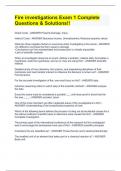Solutions Manual —Taxation of Individua ls and Business Entities by Spilker, et al. © McGraw Hill LLC. All rights reserved. No reproduction or distribution without the prior written consent of McGraw Hill LLC. 1 Solution Manual For McGraw Hill's Taxation of Individuals and Business Entities, 2024 Edition, 15th Edition Chapter 1 -25 Chapter 1 An Introduction to Tax SOLUTIONS MANUAL Discussion Questions (1) [LO 1 ] Jessica’s friend Zachary once stated that he couldn’t un derstand why someone would take a tax course. Why is this a rather naïve view? Taxes are a part of everyday life and have a financial effect on many of the major personal decisions that individuals face (e.g., investment decisions, evaluating alternative j ob offers, saving for education expenses, gift or estate planning, etc.). (2) [LO 1 ] What are some aspects of business that require knowledge of taxation? What are some aspects of personal finance that require knowledge of taxation? Taxes play an important rol e in fundamental business decisions such as the following: What organizational form should a business use? Where should the business locate? How should business acquisitions be structured? How should the business compensate employees? What is the appropria te mix of debt and equity for the business? Should the business rent or own its equipment and property? How should the business distribute profits to its owners? One must consider all transaction costs (including taxes) to evaluate the merits of a transact ion. Common personal financial decisions that taxes influence include: choosing investments, retirement planning, choosing to rent or buy a home, evaluating alternative job offers, saving for education expenses, and doing gift or estate planning. (3) [LO 1 ] Describe some ways in which taxes affect the political process in the United States. Solutions Manual —Taxation of Individua ls and Business Entities by Spilker, et al. © McGraw Hill LLC. All rights reserved. No reproduction or distribution without the prior written consent of McGraw Hill LLC. 2 U.S. presidential candidates often distinguish themselves from their opponents based upon their tax rhetoric. Likewise, the major political parties generally have very diver se views of the appropriate way to tax the public. Determining who is taxed, what is taxed, and how much is taxed are difficult questions. Voters must have a basic understanding of taxes to evaluate the merits of alternative tax proposals offered by opposi ng political candidates and their political parties. (4) [LO 2 ] Courtney recently received a speedi ng ticket on her way to the u niversity. Her fine was $200. Is this considered a tax? Why or why not? The $200 speeding ticket is not considered a tax. Instead, i t is considered a fine or penalty. Taxes differ from fines and penalties because taxes are not intended to punish or prevent illegal behavior. (5) [LO 2 ] Marlon and Latoya recently started building a house. They had to pay $300 to the county government for a b uilding permit. Is the $300 payment a tax? Why or why not? The building permit is not considered a tax because $300 payment is directly linked to a benefit that they received (i.e., the ability to build a house). (6) [LO 2 ] To help pay for the city’s new stadi um, the city of Birmingham recently enacted a 1 percent surcharge on hotel rooms . Is this a tax? Why or why not? The 1 percent surcharge is a tax. The 1 percent surcharge is an earmarked tax – i.e., collected for a specific purpose. The surcharge is consid ered a tax because the tax payments made by taxpayers do not directly relate to the specific benefit received by the taxpayers. (7) [LO 2 ] As noted in Example 1 -2, tolls, parking meter fees, and annual licensing fees are not considered taxes. Can you identify other fees that are similar? There are several possible answers to this question. Some common examples include entrance fees to national parks, tag fees paid to local/state government for automobiles, boats, etc. (8) [LO 2 ] If the general objective of our tax system is to raise revenue, why does the income tax allow deductions for charitable contributions an d retirement plan contributions? In addition to the general objective of raising revenue, Congress uses the federal tax system to encourage certain behavior and discourage other behavior. The charitable contribution deduction is intended to encourage taxpayers to support the initiatives of charitable organizations , whereas deductions for retirement Solutions Manual —Taxation of Individua ls and Business Entities by Spilker, et al. © McGraw Hill LLC. All rights reserved. No reproduction or distribution without the prior written consent of McGraw Hill LLC. 3 contributions are intended to encourage retirement savings. Another objective of the tax system is to redistribute wealth. (9) [LO 2 ] One common argument for imposing so -called sin taxes is the social goal of reducing demand for such products. Using cigarettes as an example, is there a segment of the population that mig ht be sensitive to price and for whom high taxes might discourage purchases ? The most obvious segment sensitive to price may be teenagers and younger adults that typically have less disposable income , although price sensitivity or elasticity will vary by t axpayer. (10) [LO 3 ] Dontae stated that he didn’t want to earn any more money because it would ―put him in a higher tax bracket.‖ What is wrong with Dontae’s reasoning? Although earning additional taxable income may increase Dontae ‘s marginal tax rate (i.e., pu t him in a higher tax bracket), the additional income earned does not affect the taxes that Dontae will pay on his existing income. Moving to a higher tax bracket simply means that Dontae will pay a higher tax rate on the additional income earned (not on the income that he already has). (11) [LO 3 ] Describe the three different tax rates discussed in the chapter and how taxpayers might use them. The marginal tax rate is the tax rate that applies to the taxpayer‘s additional taxable income or deductions that the t axpayer is evaluating in a decision. Specifically, Δ ( )
Δ ( )Tax NewTotalTax OldTotalTMax
TaxableIncome N larginnal oTax ewTaxab eI c me OldTaxableIncomRatee
The marginal tax rate is particularly useful in tax planning because it represents the rate of taxation or savings that would apply to additional taxable income or tax deductions . The average tax rate represents the taxpayer‘s average level of taxation on each dollar of taxable income. Specifically, Average Tax Rate = TotalTax
TaxableIncome The average tax rate is often used in budgeting tax expense as a portion of income (i.e., what percent of taxable income earned is paid in tax). Solutions Manual —Taxation of Individua ls and Business Entities by Spilker, et al. © McGraw Hill LLC. All rights reserved. No reproduction or distribution without the prior written consent of McGraw Hill LLC. 4 The effective tax rate represents the taxpayer‘s average rate of taxation on each dollar of total income (i.e., taxable and nontaxable income). Specifically, Effective Tax Rate = Total Tax
Total Income The effective tax rate provides a depiction of a taxpayer‘s tax burden because it depicts the taxpayer‘s total tax paid as a ratio of the sum of both taxable and nontaxable income earned. (12) [LO 3 ] Which is a more appropriate tax rate to use to compar e taxpayers’ tax burdens – the average or the effective tax rate? Why? Relative to the average tax rate, the effective tax rate provides a better depiction of a taxpayer‘s tax burden because it depicts the taxpayer‘s total tax paid as a ratio of the sum of both taxable and nontaxable income earned. (13) [LO 3 ] Describe the differences between a proportional, progressive, and regressive tax rate structure. A proportional (flat) tax rate structure imposes a constant tax rate throughout the tax base. In other words , as the tax base increases, the taxes paid increases, but the marginal tax rate remains constant. Because the marginal tax rate is constant across all levels of the tax base, the average tax rate remains constant across the tax base and always equals the marginal tax rate. Common examples of proportional taxes include sales taxes and excise taxes (i.e., taxes based on quantity such as gallons of gas purchased). A progressive tax rate structure imposes an increasing marginal tax rate as the tax base increas es. In other words, as the tax base increases, both the marginal tax rate and the taxes paid increase. Common examples of progressive tax rate structures include federal and most state income taxes and federal estate and gift taxes. A regressive tax rate s tructure imposes a decreasing marginal tax rate as the tax base increases. In other words, as the tax base increases, the taxes paid increases, but the marginal tax rate decreases. Regressive tax rate structures are not common. In the United States, the So cial Security tax and the federal employment tax employ a regressive tax rate structure. However, there are other regressive taxes when the tax is viewed in terms of effective tax rates. For example, a sales tax by definition is a proportional tax – i.e., as taxable purchases increase, the sales tax rate (i.e., the marginal tax rate) remains constant. Nonetheless, when you consider that the prop ortion of your total income spent on taxable purchases likely decreases as your total income in creases, you can se e the sale tax as a regressive tax.






